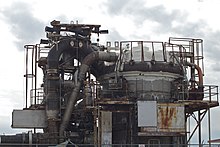WS-125
| WS-125 | |
|---|---|

| |
| Artist's rendering of the WS-125 | |
| Project for | Long-range Nuclear-powered aircraft strategic bomber |
| Requirement | WS-125 |
| Issued by | United States Air Force |
The WS-125 was an American super long-range strategic bomber project during the Cold War to develop a nuclear-powered aircraft.
Development[]
In 1954, the United States Air Force (USAF) issued a weapons system requirement for a nuclear-powered bomber, designated WS-125. In 1956, General Electric teamed up with Convair (X211 program) and Pratt & Whitney with Lockheed in competitive engine/airframe development to address the requirement.[1]
In 1956, the USAF decided that the proposed WS-125 bomber was unfeasible as an operational strategic aircraft. Finally, after spending more than $1 billion, the project was canceled on March 28, 1961.[citation needed]
Powerplants[]


Two General Electric J87 turbofan engines were successfully powered to nearly full thrust using two shielded reactors. Two experimental engines complete with reactor systems ( and , which was modified and renamed ) are currently[when?] located at the EBR-1 facility south of the Idaho National Laboratory 43°30′42.22″N 113°0′18″W / 43.5117278°N 113.00500°W.[citation needed]
See also[]
- 9M730 Burevestnik (Russia)
- Planes That Never Flew, Discovery Channel
- Project Pluto – US nuclear ramjet project, 1957-1964
- Convair NB-36H – American experimental plane (1955–61)
- Convair X-6 – US proposed nuclear-powered plane (1950s)
References[]
- ^ "Aviation History: The airplane that never was". www.aopa.org. January 1, 2018.
- Butler, Tony (2010). American Secret Projects. Hinckley, England: Midland Publishing. ISBN 978-1-85780-331-0.
- Nuclear-powered aircraft
- Cancelled military aircraft projects of the United States
- Military aircraft procurement programs of the United States
- Military aviation stubs